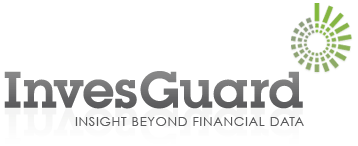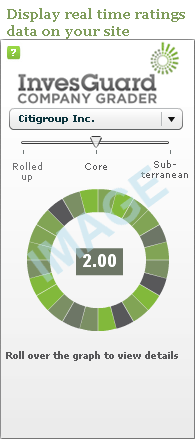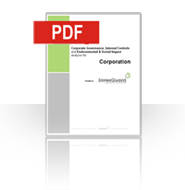-
Advantages of SubscriptionSubscription provides you the right to use all 3 levels of data.
The third and most detailed level of data which is available only to subscribers provides the most comprehensive explanation of the rating profile of companies in our database. It will provide you with information on why we think the Board Effectiveness of a company is weak or why the Audit Committee of a company can probably do better. This information may be that key element that you need over and above critical financial data to give you a complete corporate picture.
For additional information on why you should use InvesGuard please click here.
blog:
Guarding Investments one post at a time
Facelift for Corporate Governance in U.K.
"The time has come," the Walrus said,
"To talk of many things:
Of shoes--and ships--and sealing-wax--
Of cabbages--and kings--
And why the sea is boiling hot--
And whether pigs have wings."
- From The Walrus and the Carpenter by Lewis Carroll.
Hopefully, the ongoing discussion and consequent recommendations by U.K. City Banker Sir David Walker will not dissolve into a hypothetical discussion like the one by Lewis Carroll's The Walrus and the Carpenter.
The final recommendations by Sir David Walker on the state of corporate governance, particularly for banks in the U.K. was made public yesterday.
The big focus was on Board Committees and particularly the role that the board should play in the risk assessment and management process of the company. As the report puts it, boards have been discharging their risk related duties with a sense of ‘disclosure fatigue’ –full disclosure is the best way to fulfill risk related obligations by the board. In reality, boards should ensure that risks are identified in a timely manner, assessed and controlled effectively. Suitability and relevance of experience of such Board level Risk Committee members has also been examined in this report.
In addition, the Board Risk Committee should file a separate Risk Report, within the Annual Report. The report should describe thematically the strategy of the entity in a risk management context, including
1. information on the key risk exposures inherent in the strategy,
2. the associated risk appetite and tolerance and
3. how the actual risk appetite is assessed over time covering both banking and trading book exposures and
4. effectiveness of the risk management process over such exposures.
The report should also provide at least high-level information on the scope and outcome of the stress-testing program. An indication should be given of the membership of the committee, of the frequency of its meetings, whether external advice was taken and, if so, its source.
This Risk Report recommendation while good in theory may not necessarily achieve the objective. If you look at the kind of information that a typical Audit Committee report discloses, you will see what I am talking about. Other than 98% being ‘CYA’ statements, there is barely any useful information.
Sir Walker’s report also comments on other broader corporate governance measures such as stock ownership requirements for executive management.
As far as pay related regulation goes, deferral of incentive payments was the primary ‘form of attack’ with one half of variable remuneration being offered in the form of performance based long term incentives.
As per the recommendations, half of this award should be handed out only after 3 years and the remainder after 5 years. Short term bonus awards to be paid over a three year period.
At InvesGuard, we have been actively mining information on exactly this type of information. For all the banking companies in our database, we have gathered information on the presence of Board level risk committees, suitability and relevance of experience for these Committee members. We also track changes to Chief Risk Officers at Banking companies.
Register today to view Companies in our database.
Friday
November 27
New Scorecards Added –PNC Financial, Capital One, US Bancorp and State Street.
Over the past week or so, we have added 4 more companies ( PNC Financial , Capital One, US Bancorp and State Street ) to our database.
If you are an already registered subscriber, please log in and view these companies’ scores. Please click on the ‘Expand All’ link within each of the tabs that opens up the datapoints to reveal even more details. If you have any problems accessing any information drop me a line at comments@invesguard.com
If you are not a registered subscriber, I would urge you to complete the painless, FREE registration process. All the information is now freely available after a short registration process. Thank you. 3 out of these 4 newly uploaded companies (PNC Financial being the exception) have repaid monies borrowed under the TARP program. However, none of them have published details on how the money borrowed under TARP was allocated or used.
Why, you ask should they publish these details? Joe Nocera’s recent columnin the New York Times brought to light very succinctly, the lead, so to say, that Goldman (or as it is “affectionately” called the “Vampire Squid”) received by accepting the TARP money. As Joe Nocera puts it, “………………That $10 billion of TARP money meant that Goldman Sachs could free up an additional $10 billion to put to work making money — instead of having to use it to shore up its capital. Indeed, when the firm paid back the TARP money last summer, it went out and raised new capital so that it wouldn’t have to reduce the amount it could deploy to make money.”
This so called lead is as applicable to other companies that received and repaid the money, as it is to Goldman. Consequently the only logical thing for these companies to do now, is to disclose how the money was used…….how much of it was used to actually shore up the economy by lending to businesses versus using it to ‘play’ the market or perhaps just keep it idle.
One of our focus is on the experience and suitability of board members to the Board committee that they sit on with a particular emphasis on Board Audit and Board Risk Committee members. We found deficiencies in this area for Capital One, US Bancorp and State Street. In case of PNC, we found inadequate published Director information making it impossible for us to comment on the suitability of their board audit committee members.
At State Street, during 2008 the Board Executive Committee held 14 meetings while the FULL board met 16 times. While the full board consists of 14 members, the Board executive committee consists of 5 board members. The charter of this Board Executive committee grants broad powers to its members. Holding excessive executive committee meetings may diminish the ability of the full board from taking any meaningful decisions.
The other usual suspects including over stretched directors, CEO on the board of other public companies, inadequate disclosures of Social and Environmental information also grace the scorecards of these companies.
Next Week: Look out for Bank of New York Mellon, Duke Energy and Hartford.
Wednesday
November 25





